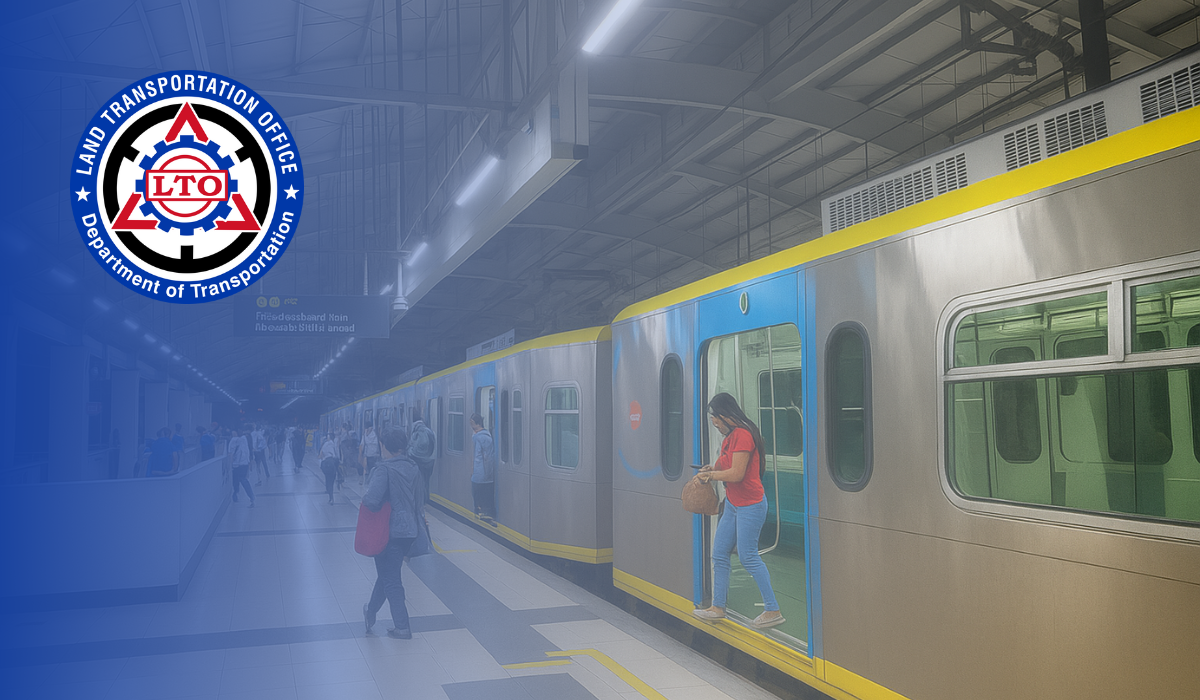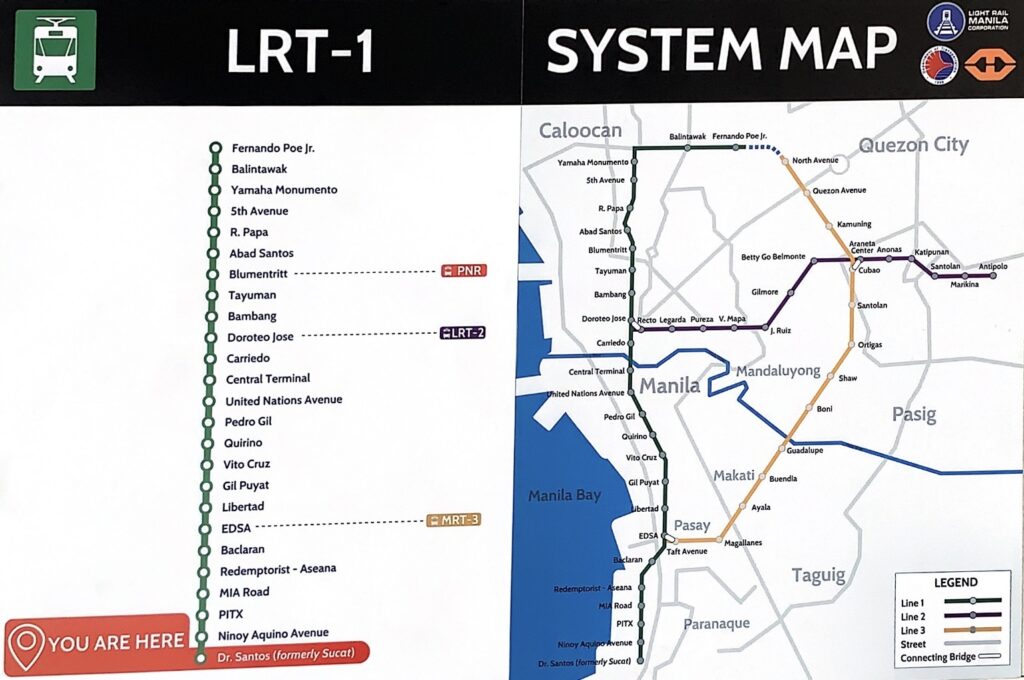List of LRT-1 Stations Complete Guide

List of LRT-1 Stations Complete Guide. The Manila Light Rail Transit System Line 1 (LRT-1) is a prominent rail system established by former President Ferdinand E. Marcos in 1980, and operational since December 1984, is a crucial component of Manila’s transportation infrastructure, providing quick and convenient travel options. Since it is the earliest light rail system in the Philippines and the second in Asia, it is commonly referred to as the Green Line. This public transportation system is operated by the Light Rail Manila Corporation (LRMC) across twenty stations across Metro Manila, providing access to Pasay, Manila, Caloocan, and Quezon City.
The LRT-1 has been a pioneer in the development of light rail transit systems in Southeast Asia since it was inaugurated in 1984. It provides commuters with a convenient method of transportation across urban areas. Along Taft Avenue and Rizal Avenue, it traverses the north-south corridor of Metro Manila, connecting Baclaran in Pasay City with Roosevelt in Quezon City. There are currently only two LRT lines operating, with LRT-1 being one of them. Future plans include expanding the line and adding more train wagons to meet the needs of the nearly 800,000 passengers each day.
What is LRT-1 and Where is It Located?
The LRT-1, or Light Rail Transit Line 1, is one of the light rail rapid transit systems that operate in Metro Manila. Currently operated by the Light Rail Manila Corporation (LRMC), this train system is also called the Green Line. One of the few existing train systems in the metropolis is the Light Rail Transit Line 2 (LRT-2) and the Metro Rail Transit (MRT-3) as well as a commuter line operated by Philippine National Railways.
With the inauguration of the first segment of LRT-1 in 1984, LRT-1 is considered to be Southeast Asia’s first light rail system. In Metro Manila, it traverses four cities, namely Pasay, Manila, Caloocan, and Quezon City.

LRT-1 Stations List In Order
Traffic congestion and intense heat can make commuting in the National Capital Region (NCR) physically and mentally draining. With its twenty strategically situated stations spanning four cities, the LRT-1 serves more than 275,000 passengers per day, providing a dependable and effective transportation solution in the region. As a next step, let’s examine a comprehensive list of the stations on the LRT-1, as well as the prominent destinations that are accessible from each station.
Baclaran Station
The Baclaran Station is located at the southernmost tip of Line 1, and is a popular destination for commuters traveling north. The station is within walking distance of vibrant markets and shopping centers as well as key landmarks including the Ninoy Aquino International Airport (NAIA) and the SM Mall of Asia.
EDSA Station
EDSA Station serves as a crucial commuter transfer point for commuters traversing northbound routes along EDSA, the iconic thoroughfare it intersects. This station offers seamless connectivity across Metro Manila thanks to its proximity to major bus terminals and shopping complexes like SM Mall of Asia.
Libertad Station
Libertad Station, which was previously known as Arnaiz Station, serves commuters in Pasay City. The station is strategically situated near diplomatic offices and commercial establishments, making it a popular transit point for both locals and tourists.
Gil Puyat Station
This vibrant business district and cultural landmarks are just a short walk away from Gil Puyat Station, located at the heart of Makati. There are a variety of destinations within Metro Manila that can be reached conveniently from this station, including the World Trade Center and SM Mall of Asia.
Vito Cruz Station
Vito Cruz Station is located among educational institutions and cultural landmarks, making it an ideal spot for students and tourists exploring Manila’s vibrant arts and heritage scene. De La Salle University and the Cultural Center of the Philippines are located nearby, making this station an excellent place to experience enriching experiences.
Quirino Station
The Quirino Station, which serves Manila’s historic district of Malate, is a convenient and convenient way to reach the city’s iconic landmarks and leisure destinations. From Manila Zoo to Manila Baywalk, this station provides travelers with a unique opportunity to explore the cultural heritage and natural beauty of the city.
Pedro Gil Station
The Pedro Gil Station is located in the bustling business district of Ermita in Manila, providing easy access to nearby shopping centers and educational institutions. You will have seamless connectivity to Robinsons Place Manila or University of the Philippines Manila, regardless of whether you are visiting the mall or the university.
UN Avenue Station
UN Avenue Station is ideally situated close to government offices and cultural institutions and serves as an important transit point for commuters exploring Manila’s historic landmarks and scenic attractions.
Central Terminal Station
The Central Terminal Station is a convenient gateway to Old Manila’s ancient heritage and cultural landmarks, including Intramuros and Rizal Park. Because of the station’s proximity to educational institutions and museums, this station offers an excellent opportunity for learning and exploration.
Carriedo Station
The Carriedo Station is ideally located in the center of the bustling market districts and historical landmarks of Manila. It offers a glimpse into the vibrant street life and cultural heritage of the city. Travelers can immerse themselves in the city’s bustling markets and religious attractions from this station, which connects Binondo with Quiapo.
Doroteo Jose Station
Stationed at Doroteo Jose, a local hero’s name, it serves as a vital transit point for commuters between Manila’s busy districts. In addition to being strategically positioned near universities and shopping centers, this station ensures seamless connectivity for passengers.
Bambang Station
Bambang Station is a hotel located near medical institutions and educational institutions that caters primarily to students and healthcare professionals. This station offers convenient access to a number of key destinations, including University of Santo Tomas and Jose Reyes Memorial Medical Center.
Tayuman Station
The Tayuman Station acts as a gateway to the city’s vibrant districts, providing convenient access to shopping centers and cultural attractions. This station provides seamless connectivity to Dangwa Flower Market and SM City San Lazaro, whether you’re exploring Dangwa or SM City.
Blumentritt Station
The Blumentritt Station serves as an important transit hub for commuters traveling between Manila’s diverse districts, offering convenient access to shopping centers and cultural attractions. This station offers travelers the chance to experience Manila’s vibrant street life and heritage, whether they are exploring Santa Cruz or Tondo.
Read also: LTO Offices Philippines – LTMS Portal Office
Abad Santos Station
This station offers convenient access to key destinations within Tondo and Santa Cruz, located amid bustling residential neighborhoods and commercial centers. The station’s seamless connectivity ensures seamless connectivity for commuters, whether they’re visiting local markets or medical institutions.
R. Papa Station
The R.Papa Station offers easy access to Manila’s residential neighborhoods and cultural landmarks due to its place at the crossroads of Manila’s busy districts. The station offers travelers the opportunity to experience Manila’s diverse communities, whether they are exploring La Loma Cemetery or Marulas Elementary School.
5th Avenue Station
The 5th Avenue Station is an excellent entry point to the vibrant districts of Caloocan. It offers convenient access to shopping centers and educational institutions. The station ensures seamless connections for commuters whether they are visiting the Thai To Taoist Temple Pagoda or Northern Rizal Yorkin Chinese School.
Monumento Station
Monumento Station provides convenient access to key destinations within Caloocan and neighboring cities, nestled among bustling commercial centers and historical monuments. This station allows travelers to experience Caloocan’s vibrant street life and rich heritage, whether they are visiting Monumento Circle or SM City Grand Central.
Balintawak Station
Balintawak Station is a gateway to the busy districts of Quezon City. Shopping centers as well as residential neighborhoods are easily accessible from the station. This station provides seamless connectivity for commuters, whether they are visiting Ayala Malls Cloverleaf or Landers Superstore.
Fernando Poe Jr. Station
The area formerly known as Roosevelt Station today serves as the northern terminus of the LRT-1 and previously known as The Roosevelt Station. This station offers easy access to key destinations within Quezon City and further afield due to its proximity to major landmarks and transportation hubs.
LRT-1 Stations in Order Maps

Additional LRT-1 Stations
The LRT-1 network will undergo further expansion with the completion of the Cavite Extension Project, which will add eight new stations to the existing network. As additional stations are being built between Redemptorist Station and Niog Station, commuters traveling between Cavite and Metro Manila will have improved connectivity and accessibility.
LRT-1 Stations – Video Guide
Schedule
LRT-1 trains operate according to the following schedule:
| Direction | Day Type | First Train | Last Train |
|---|---|---|---|
| From Baclaran | Weekdays, Weekends, Holidays | 4:30 a.m. | 10:00 p.m. (Weekdays) / 9:30 p.m. (Weekends & Holidays) |
| From FPJ | Weekdays, Weekends, Holidays | 4:30 a.m. | 10:15 p.m. (Weekdays) / 9:45 p.m. (Weekends & Holidays) |
Payment
Services provided by LRT-1 can be paid for at the following locations:
| Payment Location | Available Payment Methods |
|---|---|
| LRT Teller Booths | – Single-use journey cards – Beep™ cards – Stored value cards |
| LRT Teller Machines | – Single-use journey cards – Beep™ cards – Stored value cards |
Using LRT-1 Stations: Dos and Don’ts
There are a few things commuters should do and don’t do to ensure safety and convenience:
- Within the stations, you may not eat, drink, or smoke.
- During transit, hold onto the safety handrails.
- Leaning against train doors is not a good idea.
- Safeguard belongings by paying attention to the environment.
- Do not unnecessarily touch emergency devices.
Interesting Facts and Trivia
Here some interesting facts:
- A rapid transit system was first introduced in Southeast Asia with the LRT-1.
- A structure built on an elevated platform can withstand earthquakes of magnitude 8 or higher.
- There are three interchanges between LRT-1 stations: Doroteo Jose connects to LRT Line 2, Blumentritt connects to the PNR Metro Commuter Line, and EDSA connects to MRT Line 3.
- It was initially known as Metrorail and the Yellow Line before being renamed to the Green Line.
- To accommodate the increasing number of passengers, the original two-car trains were converted into three-car and four-car trains.
- LRT systems, such as the LRT-1, run on their own dedicated rights-of-way and have priority signaling at intersections, allowing them to provide faster and more efficient service.
FAQs ABout LRT-1 Stations
What cities does the LRT-1 serve in Metro Manila?
Ans: The LRT-1 serves four key cities in Metro Manila: Pasay, Manila, Caloocan, and Quezon City, with plans to expand to Cavite through the Cavite Extension Project.
What are the operating hours of LRT-1 trains?
Ans: LRT-1 operates daily starting at 4:30 a.m.. The last train from Baclaran departs at 10:00 p.m. on weekdays and 9:30 p.m. on weekends/holidays. From Fernando Poe Jr. Station, the last train leaves at 10:15 p.m. (weekdays) and 9:45 p.m. (weekends/holidays).
What are the payment methods accepted by LRT-1?
Ans: Passengers can pay for their journeys using:
- Single-use journey cards
- Beep™ cards
- Stored value cards
These can be purchased at LRT teller booths or teller machines.
What are some major landmarks accessible via LRT-1 stations?
Ans: LRT-1 provides access to major landmarks such as:
- SM Mall of Asia (via Baclaran or EDSA Station)
- De La Salle University (via Vito Cruz)
- Intramuros and Rizal Park (via Central Terminal)
- Robinsons Place Manila (via Pedro Gil)
- Monumento Circle (via Monumento Station)
Is LRT-1 expanding to Cavite?
Ans: Yes, the Cavite Extension Project will add eight new stations, significantly improving connectivity between Metro Manila and Cavite. New stations will extend the line beyond Redemptorist Station to Niog Station.
Conclusion
The LRT-1 continues to serve as the backbone of Metro Manila’s public transport system, linking four major cities with reliable and fast service. As the first light rail system in Southeast Asia, it not only offers convenience to daily commuters but also supports urban growth and sustainability. With ongoing expansions and upgraded facilities, LRT-1 remains a vital solution for addressing traffic and enhancing mobility across the metropolis.






